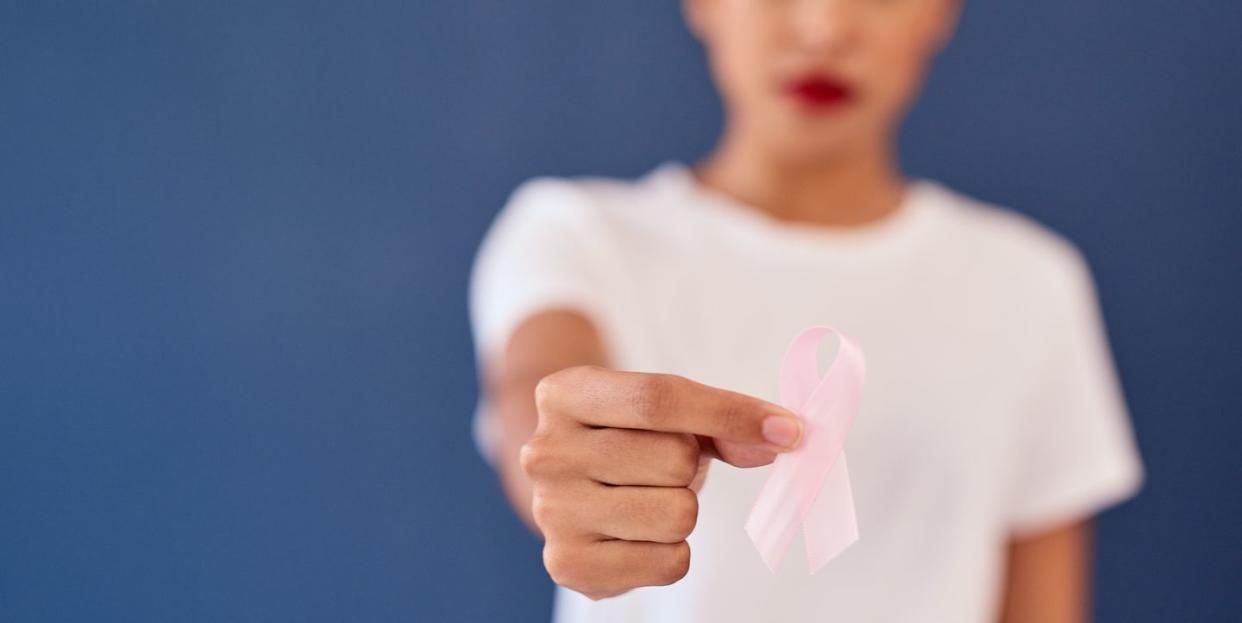Don't Fall for These Common Breast Cancer Myths

Everyone knows what those ubiquitous pink ribbons signify, and what's going on when armies of pink t-shirted women and their loved ones march through cities and suburbs to raise money for research. And it's obviously a good thing that breast cancer is no longer the taboo subject it was last century, when too many women were embarrassed to seek the care and support they needed early enough to save their lives.
But with all the information out there (and with one in eight women being diagnosed in their lifetimes) there are also some myths that can get in the way of early detection and treatment. Ahead we're sharing what's fact and what's fiction when it comes to breast cancer.
Myth #1 If you don't have a lump, you don't have breast cancer.
Many women don’t have a lump when their cancer is found on a mammogram, says Dawn Mussallem, D.O., a hematology and oncology breast health specialist with the Mayo Clinic in Jacksonville, FL. Still, it’s important to keep an eye (or hand) out for any change in your breasts and tell your doctor right away, says Susan Brown, R.N., managing director of education and patient support for the nonprofit breast cancer organization Susan G. Komen. Signs of cancer can include thickening or swelling of the breast, redness or flakiness around the nipple, puckering of the skin, inverting of the nipple, discharge, breast pain, and a change in size or shape. But if you do find a lump, don’t panic—the majority of lumps are benign, Dr. Mussallem says.
Myth #2 The fight against breast cancer is nearly won.
Despite all the awareness, breast cancer is still a big worry. It’s the second most common cancer in women (skin cancer comes first) and the second deadliest (after lung cancer). This year, some 279,100 people will be diagnosed and 42,690 will die of it. From 2012 to 2016, the latest period for which data is available, cases of invasive breast cancer crept up.
Still, we’ve made remarkable progress: Breast cancer–related deaths have dropped an astounding 40% since 1989. That’s been largely due to early detection, a decrease in hormone-replacement therapy, and better, more targeted treatment, says Brown. A hope for the future, she says, is that detection will one day be as simple as doing a blood or urine test, and that more clinical trials and more equitable access to health care can save even more lives.
Myth #3 Breast cancer is breast cancer.
Breast cancer is not a single disease, but “a family of diseases, each with its own personality,” Brown says. Some involve a type of protein that causes cancer cells to grow; some (like estrogen- or progesterone-receptor-positive tumors) are sensitive to hormones, while others are not. How cancer grows and how it’s treated (chemo, surgery, other medications, or a combination) can vary based on the type or subtype of breast cancer it is. The most common kind, accounting for 70% to 80% of cases, is invasive ductal carcinoma, which starts in the milk ducts and then spreads, says Dr. Mussallem. Other types of invasive breast cancer include invasive lobular carcinoma and inflammatory breast cancer, a rare, fast-growing cancer that is more common in Black women and women who are obese.
Myth #4 If you don’t have a family history, you don’t have to worry much.
Mythbuster About 85% of women who get breast cancer have no close relative with a history of the disease, which is why “every woman is at risk and needs to watch for signs and get her mammograms,” says Brown. The two biggest risk factors are being born a woman and getting older. Others include dense breast tissue and high BMI.
Still, a family history does matter. Your risk nearly doubles if you have a first-generation relative (mother, sister, daughter) who has had it, Brown says. And 5% to 10% of breast cancers are the result of rare inherited mutations in the BRCA1 and BRCA2 genes, which increase risk by as much as 70% before age 70 and are more likely to be found in women with Ashkenazi Jewish heritage. If you’re at higher risk, talk to your doc about preventive measures like medication, surgery, and early screenings.
Myth #5 There’s little you can do except get screened and watch for signs.
Your weight, how often you exercise, your alcohol and tobacco use, and the hormones you take all play a role in your breast cancer risk, Dr. Mussallem says. Maintaining a healthy weight is very important, as obesity makes postmenopausal breast cancer risk 1.5 to 2 times higher. According to the U.S. Centers for Disease Control and Prevention, physical activity could prevent one in eight breast cancer cases. In addition, research suggests that getting sweaty regularly can lower breast cancer risk by 10% to 20% for all women—including those at very high risk.
Also, watch how much alcohol you drink. Women who have two or three drinks a day have 20% higher odds of breast cancer, but “any amount of alcohol increases breast cancer risk, and the more you drink, the higher your risk,” Dr. Mussallem says. It’s a good idea to go easy, whatever your family history.
Support from readers like you helps us do our best work. Go here to subscribe to Prevention and get 12 FREE gifts. And sign up for our FREE newsletter here for daily health, nutrition, and fitness advice.
You Might Also Like

